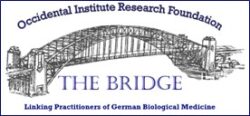For Cerebral Function
The old age related decrease of cognitive abilities (like perception, thinking, recognizing and remembering, up to dementia) has various causes. From the perspective of Orthomolecular Medicine the following aspects are of special interest at the same time:
- Oxidative stress and chronic inflammation as a cause of disturbance of the stimulus conduction or also structural impairment/degeneration
- Nutrients as antioxidants and inflammation inhibitors
- Nutrients like omega-3 fatty acids as important building blocks of nerval structures
- Nutrients as transmitter precursors
Oxidative Stress
D. Harman already postulated the causal connections between oxidative stress and neuro-degenerative illnesses in 1956. In recent years this has been proven in many studies. The brain utilizes large quantities of oxygen and shows high energy requirements. From this a very high OXPHOS (oxidative phosphorylation) activity arises with the danger of a similarly strongly increased ROS (reactive oxygen species) development. With increasing age, the vulnerability of the brain and nervous system increases with respect to oxidative stress. This manifests for example in a loss of reduced glutathione and increased levels of oxidized glutathione, increased lipofuscin accumulation and in increased peroxidation of membrane lipids. Beyond that a strong increase of auto-oxidation processes, e.g. dopamine, occurs with age.
Chronic Inflammation Processes
Inflammatory processes increase with increasing age, also in the brain. This manifests as raised pro-inflammatory cytokine, like TNF-a or interleukin-6, or in the high level regulation of CRP (C-reactive proteins). Oxidative stress and chronic inflammation mutually induce and maintain each other. They constitute the essential external cause of all degenerative and old age related disturbances and impairments.
Antioxidants
Individual micro-nutrients or substance mixtures of plant origin are used as antioxidants and to reduce inflammatory processes. Important single substances in connection with neurodegenerative illnesses are, for example:
- Reduced glutathione
- Coenzyme Q10
- Acetylcarnitine
- a-lipoic acid
- Vitamin C
- Selenium
Important plant substances with anti-oxidative as well as anti-inflammatory properties are above all the polyphenols (anthocyanins, catechol, quercetin, etc.), the carotenoids, or also the curcuminoids. Compared with the high oxygen turnover and the high concentration of oxidation sensitive fatty acids, the provision of the brain with antioxidants is rather insufficient.
A quite essential but often not considered anti-oxidative and anti-inflammatory active substance in the brain is melatonin. It exhibits not only a neuro-protective, but also a neuro-regenerative effect.
Omega-3 Fatty Acids
50-60% of the dry weight of the human brain consists of lipids, of which there are about 35% long chain unsaturated fatty acids, especially AA (arachidonic acid) and DHA (docosanoic-hexonic acid). AA is also found in high amounts in many other tissues. DHA occurs in high concentrations predominantly in the brain as well as in the retina or in the testicles. The importance of DHA for cerebral development (visual function, cognitive abilities, plasticity, etc.) is proven by studies and is already traced back to the importance for membrane fluidity on the one hand and to the very high degree of cell membrane formation during cerebral development on the other hand. An optimal development of brain, nervous system and eyes is thus dependent to a high degree upon a sufficient supply of DHA in pregnancy and during early childhood maturing. This is to be observed above all with children who are not breastfed. The supply of alpha linolenic acid as a source substrate for the endogenic transformation into DHA is absolutely insufficient. In fact a high dose supply of alpha linolenic acid can somewhat increase the content of EPA (eicosanoic-pentanoic acid) in the mother’s milk, however not the DHA.
All essential metabolism processes are dependent on the undisturbed functional ability of the cell membranes. The higher the biochemical requirement of the membrane, the higher its fluidity must be. It is determined by the composition of the fatty acids within the membrane. The higher the portion of high unsaturated fatty acids like EPA and DHA is in the membrane, the higher its fluidity and, in the final analysis, its biochemical functionality, but also its oxidation sensitivity.
Especially high biochemical demands are made on the brain or in the retina, therefore the DHA portion is especially high here. The endogenic transformation of short chain omega-3 fatty acids like ALA (alpha linolenic acid) in EPA or DHA is very much limited. With undisturbed function of the enzymes involved in this transformation only approximately 5% of the supplied ALA in EPA and less than 1% in DHA can be converted. Therefore, a sufficient supply of EPA and DHA with food is indispensable. Anthropological studies show that people are at the best adapted to the ratio of anti-inflammatory omega-3 to pro-inflammatory omega-6 fatty acids from 1:1 or 1:2 in their food. The “industrial diet” causes a ratio of 1:20. Very frequently this leads to chronic inflammatory metabolism situations (low level inflammation), which are regarded as an important cause of chronic illnesses like neurodegenerative illnesses.
The high content of EPA and DHA in the brain serves on the one hand to guarantee membrane fluidity and on the other hand for protection before the pro-inflammatory processes, e.g. from the metabolism of the arachidonic acid which is also a component of the cell membranes in the brain. Anti-inflammatory eicosanoids are synthesized from EPA, and anti-inflammatory and neuro-protective ducosanoids (like docosatriene, resolvine and protectine) are synthesized from DHA.
Recommendations for the Practice
An important step for the preservation of cognitive abilities as well as other cerebral achievements is constant mental and also motor activity. As in other areas, it is also valid for cognition and cerebral performance: “Constant training makes the master”.
Prevention already begins in the womb. A sufficient supply of omega-3 fatty acids, especially DHA, must be guaranteed during pregnancy and early childhood development. Equalization of a deficiency in the mother, or for pure prophylaxis, cannot occur through alpha-linolenic acid, but rather only through a dose of DHA.
With increasing age both oxidative stress and chronic inflammatory processes increase in the brain as the cause of functional and degenerative disturbances and impairments. Disturbances and impairments can frequently be prevented and/or reduced by early use of substitution with anti-oxidative/anti-inflammatory active substances. Besides the known micro-nutrients like:
- Glutathione (e.g. as precursor N-acetylcysteine ca. 600 mg/d)
- Coenzyme Q10 (200-300 mg/d)
- Alpha-lipoic acid (300-600 mg/d)
- Vitamin C (2 x 500 mg/d)
- Vitamin B1 (50 mg benfotiamin/d)
and secondary plant materials (e.g. anthocyanin, quercetin, curcumin), melatonin should also be used (possibly as a precursor 5-hydroxytryptophan) and absolutely pay attention to the sufficient and balanced supply of omega-3 fatty acids. To be able to evaluate and adjust the treatment course, a previous laboratory analysis of the assigned substances is strongly advised.
Overview: Influence of the Fatty Acids on Neural Functions
- Change of the membrane composition and thereby influencing the ion transport channels, the activity of the membrane-constant proteins, the trans-membranous material transportation or also the stimulus conduction
- Change of membrane receptors
- Function of the fatty acids as a “second messenger” if they are dissolved out through phospholipase by their connection with the phospholipids of the cell membrane
- Influencing of the genetic expression (direct connection to transcription factors)
- Eicosanoid- or docosanoid- regulation
- Influencing of the transmitter balance
 An Exclusive Translated Article for Members
An Exclusive Translated Article for Members
From THE BRIDGE Newsletter of OIRF
Published September 2009
From an article in Zeitschrift für Orthomolekulare Medizin, Nr. 2 / 2009
Machine Translation by SYSTRAN, Lernout & Hauspie, LogoMedia & Promt
Translation & redaction by: Carolyn L. Winsor, OIRF
© Copyright 2009, Dr. Hans-Peter Friedrichsen, Merdingen, Germany



